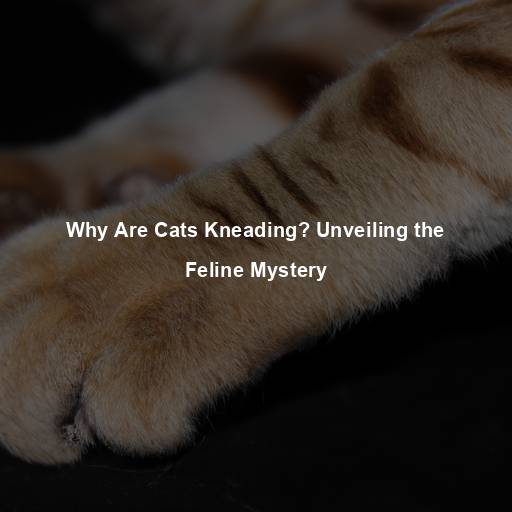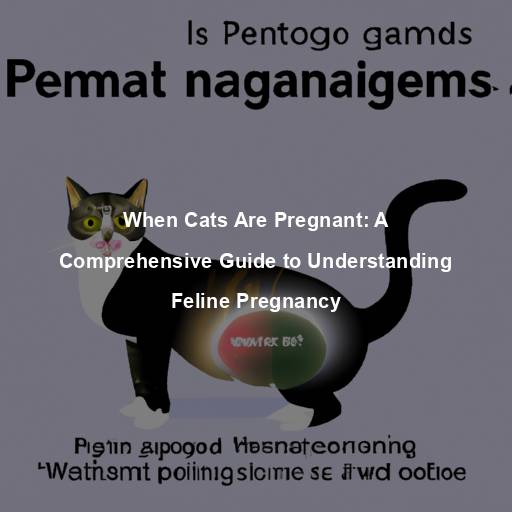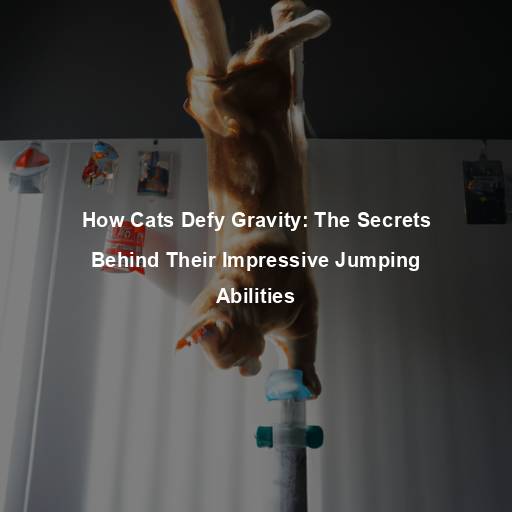Why Are Cats Kneading? Unveiling the Feline Mystery
Last Updated on November 14, 2023 by Evan
Contents
- 1 Unraveling the Enigma of Kneading Behavior
- 1.1 Instinctual Remnants of Early Development
- 1.2 Marking Territory and Claiming Ownership
- 1.3 Expression of Contentment and Relaxation
- 1.4 Stretching and Exercising Muscles
- 1.5 Nurturing Instincts and Comfort-Seeking Behavior
- 1.6 Stress Relief and Anxiety Reduction
- 1.7 Associating Kneading with Positive Experiences
- 2 Embrace the Fascinating Quirks of Your Feline Companion
- 3 Celebrating the Quirks and Charms of Cats
- 4 Embracing the Intriguing Enigma of Kneading
- 5 FAQs – Why are Cats Kneading?
Unraveling the Enigma of Kneading Behavior
Cats, those enigmatic beings that effortlessly weave their way into our lives, never cease to amaze us with their idiosyncrasies. Among the many perplexing behaviors they exhibit, one that leaves many owners and admirers scratching their heads is kneading. Have you ever noticed your feline companion rhythmically pressing their paws against blankets or even your own lap? It’s a curious sight indeed.
Instinctual Remnants of Early Development
Delving into the perplexing world of feline behavior, we find ourselves unravelling the enigma behind why cats engage in the curious act of kneading. As we explore their early development, a burst of understanding emerges. You see, when kittens are nestled against their mother’s warm belly, kneading helps to stimulate the flow of life-sustaining milk, a crucial survival instinct. But here’s where things get intriguing – even as these furballs grow into independent creatures, the perplexing pattern of kneading can resurface, almost as if propelled by fond memories of those precious moments of bonding with their nurturing mother.
Marking Territory and Claiming Ownership
Did you know that cats have a fascinating way of expressing ownership? It turns out that they have scent glands in their paws and when they knead, they release pheromones. These pheromones serve as a means of communication, allowing cats to mark their territory. So, next time you see your furry friend kneading away, just remember, they’re claiming their space and saying, “This belongs to me”!
Expression of Contentment and Relaxation
Have you ever wondered why your furry feline friend engages in that peculiar behavior of kneading against you or a cozy surface? Well, fret no more, for we are here to unveil the enchanting secrets behind this endearing gesture. When your whiskered companion gracefully flexes their paws in rhythmic motion, it’s like a melody of comfort and serenity – a genuine testament of their blissful state. It’s their way of saying “I trust you, I feel secure in your presence, and I cherish our bond”.
Stretching and Exercising Muscles
Kneading can also serve as a means for cats to stretch and exercise their muscles. As they push their paws against a surface, they engage various muscle groups, including the shoulders, legs, and paws. This activity helps to keep their muscles toned and supple. So, while it may appear odd to us, kneading is a natural way for cats to maintain their physical well-being.
Nurturing Instincts and Comfort-Seeking Behavior
Another possible reason for kneading behavior is rooted in a cat’s nurturing instincts. When cats knead, they may exhibit behaviors similar to those they displayed during their early nursing days. Some cats may even knead on soft objects, such as blankets or pillows, as a way to simulate the comforting sensation of being close to their mother. It’s their way of seeking comfort and security in their surroundings.
Stress Relief and Anxiety Reduction
In addition to seeking comfort, kneading can also serve as a stress-relieving mechanism for cats. Similar to how humans may engage in activities like knitting or doodling to alleviate anxiety, cats may find solace in kneading. The repetitive motion and the release of endorphins during this activity can help reduce stress and promote a sense of calmness. So, if your cat kneads more frequently during certain situations, it could be their way of coping with anxiety or nervousness.
Associating Kneading with Positive Experiences
Over time, cats may come to associate kneading with positive experiences and outcomes. For instance, if they receive attention, praise, or treats while kneading, they may be more inclined to repeat the behavior. This positive reinforcement can reinforce the habit of kneading and make it a recurring behavior in certain situations. Cats are intelligent creatures that quickly learn what behaviors lead to favorable outcomes.
Embrace the Fascinating Quirks of Your Feline Companion
Cats possess an innate ability to bewitch us with their mysterious antics, leaving us perplexed and utterly captivated. Among their enigmatic behaviors, kneading stands out as a particularly perplexing phenomenon. Is it a vestige of their primal past, a method of asserting dominance, or a humble quest for solace? Such intricate complexities lie at the heart of our fascination with these inscrutable feline companions.
As devoted guardians of our feline friends, we must embrace and appreciate these peculiar behaviors as inherent traits that make each cat so wonderfully diverse. By delving into the mysteries behind their kneading instincts, we can forge stronger connections with these enigmatic creatures and create an environment that caters to their individual needs, fostering their overall well-being.
Have you ever wondered why your beloved feline companion kneads on you? Well, buckle up because we’re diving into the intriguing realm of the science behind kneading behavior. Prepare to be fascinated as we unlock the secrets behind this perplexing yet adorable display of affection that makes the bond between humans and cats even more profound. Get ready to unravel the mysteries, because there’s more to your cat’s kneading than meets the eye.
The Role of Genetics and Evolution
When it comes to those adorable kneading moments, we can’t help but wonder what’s behind our feline friends’ unique behaviors. It turns out that the fascinating world of genetics and evolution plays a compelling role in shaping a cat’s kneading tendencies. From the regal Siamese cats to the cuddly Ragdolls, these breeds have been known to display a burst of kneading prowess, leaving their marks on our hearts. It seems that certain genetic traits might hold the key to unraveling the perplexing nature of our feline companions’ kneading habits.
From an evolutionary perspective, kneading could have served a practical purpose for wild cats. In the wild, cats would knead the ground or vegetation to create a comfortable spot for resting or giving birth. This behavior may have provided them with a sense of security and helped them prepare their environment for nurturing their young.
The Influence of Socialization and Early Experiences
When it comes to our fluffy feline friends, their behavior is intricately woven with their early socialization and experiences. As they embark on their journey of growth, kittens learn the ropes from their wise matriarch and playful littermates, soaking up valuable lessons by observing and imitating their feline companions. Interestingly, if a kitten’s mother happens to have a penchant for kneading, this adorable act is more likely to become second nature to the little one. It truly is a fascinating world of kitty dynamics!
The way we treat kittens in their crucial early weeks can have a major influence on their personalities as adults. If they are showered with kind, loving attention and treated with gentleness during this critical stage of their growth, they are more prone to exhibit the adorable behavior of kneading as a means to find solace and show their bliss. It’s fascinating how the nurturing they receive in their formative days can shape them into the charming feline beings we adore.
The Connection Between Kneading and Emotional Bonding
Cat’s kneading is more than just a cute display of affection – it’s a profound way for them to forge emotional connections with their human counterparts. As feline paws gently work their magic, they are essentially beckoning for physical closeness and yearning for tender moments with their beloved owners. It’s a silent language of longing, where cats communicate their need for love and establish a precious sense of intimacy. So, next time your furry friend kneads away, take a moment to appreciate the depth of their desire for affection and cherish the bond you share.
There’s something inexplicably captivating about the gentle rhythmic cadence of a cat kneading its paws against a willing recipient. A mesmerizing dance that seems to transcend language and understanding, leaving both parties immersed in a state of tranquil bliss. As the cat’s paws work their magic, an exquisite release of endorphins is unlocked, enveloping their human companion in a cocoon of serenity and contentment. It is within this harmonious exchange that a profound connection is nurtured, weaving threads of trust and camaraderie that intertwine the feline and their human in a tapestry of shared moments.
Different Styles of Kneading
Cats, those captivating creatures, never cease to amaze us with their idiosyncrasies. Take kneading, for instance – a ubiquitous behavior among these feline friends, yet the ways they go about it are as diverse as their personalities. Some cats opt for an uninhibited approach, extending their claws like tiny warriors as they create their delectable kitty biscuits on a plush surface. In contrast, there are those more delicate souls who prefer a refined touch, keeping their claws tucked away as they engage in a graceful and understated kneading dance.
It’s important to note that although kneading can be a pleasurable experience, some cats may accidentally scratch their owners during the process. Trimming their claws regularly and providing appropriate scratching surfaces can help minimize any potential discomfort.
Redirecting Kneading Behavior
When your feline companion’s incessant kneading starts to overwhelm or disrupt your peaceful abode, fear not! There are effective ways to divert their attention towards more suitable outlets. Equipping your home with enticing scratching posts or comfortable mats can work wonders, channeling their innate kneading instincts in a constructive manner. Help them discover these designated zones by gently guiding their precious paws and rewarding their commendable scratching endeavors with praise or delectable treats.
Did you know that providing your feline companion with a range of captivating toys and engaging play sessions can do wonders in channeling their boundless energy and keeping their minds sharp? By indulging in playful activities, not only will you be helping your furry buddy burn off that excess energy, but you will also be deepening the special connection you share. So, go ahead and discover the joy of interactive playtime for a more contented and stimulated kitty!
When to Seek Veterinary Advice
In most cases, kneading behavior is normal and harmless. However, if you notice any sudden changes in your cat’s kneading habits or if they display signs of discomfort or pain during kneading, it’s advisable to consult with a veterinarian. They can assess your cat’s overall health and address any underlying issues that may be causing discomfort.
Celebrating the Quirks and Charms of Cats
Cats never fail to fascinate us with their unique behaviors and idiosyncrasies. Kneading is just one of the many ways in which they express themselves and establish connections with their human companions. By understanding the reasons behind kneading behavior and nurturing a positive environment for our feline friends, we can deepen our bond with them and create a harmonious and fulfilling relationship.
Every cat owner knows the feeling – the gentle pressing of their paws against your lap, as if they’re kneading dough. But have you ever wondered why cats do this? It turns out, there’s more to this seemingly innocent behavior than meets the eye. In fact, kneading has a deep cultural and historical significance that spans across different regions and eras, leaving us perplexed and in awe of our feline friends.
Kneading in Mythology and Folklore
The mesmerizing kneading habit of feline companions has long captivated both contemporary cat enthusiasts and woven itself into the intricate tapestry of myths and legends that have molded our history. An enduring connection can be traced back to the cherished ancient Egyptian civilization, where cats reigned as celestial beings of reverence and awe. The illustrious goddess Bastet, depicted gracefully with the regal visage of a lioness or tender domestic feline, embodied the essence of fertility, safeguarding, and nurturing maternal instincts. In the enigmatic act of kneading, these ancient tales whisper of an ancient power, a metaphorical representation of the goddess’s profound ability to nurture and usher forth bountiful new beginnings.
In the realm of Norse mythology, a captivating tale unfurls where the enchanting Freyja, revered as the epitome of love, beauty, and fertility, enchants all with her mythical chariot. Transported by a striking duo of majestic felines, their ethereal paws gracefully tracing the ground, whispers of profound fortune and abundance trailed in their wake. This mesmerizing link, where cats intertwine with positive mystique, illuminates the age-old ritual of kneading, an ancient practice that transcends time and culture.
Kneading as a Cultural Phenomenon
The fascinating behavior of kneading extends its mesmerizing reach beyond the cozy confines of our furry companions. Deep within the wild souls of feline kindred, this ancient act of rhythmic motion finds its ancestral origins. As we traverse diverse corners of our magnificent globe, an intricate tapestry of interpretations unfurls, painting a vivid portrait of the enigmatic nature of kneading. From ancient rituals to timeless traditions, the perplexity and allure of this mystifying behavior continue to captivate the curious minds of humankind.
For example, in Japanese folklore, the legend of the “maneki-neko” or “beckoning cat” is popular. These figurines depict a cat with one paw raised in a beckoning gesture. This gesture is reminiscent of the kneading motion and is believed to bring good luck and fortune to its owner.
It’s absolutely fascinating how certain behaviors in different cultures hold intriguing meanings. Take kneading behavior in cats, for example. Did you know that in some cultures, this adorable gesture is actually believed to have the power of weather prediction? According to captivating folklore, if a cat kneads with its back to the fireplace, it suggests that cold weather is on its way, while if it faces the fireplace during this delightful ritual, it signifies the arrival of warmer days.
Kneading and Cat Communication
Cats, those enigmatic creatures of mystique, possess a myriad of complex and nuanced ways to convey their thoughts and desires. Among these enigmatic techniques lies the art of kneading, a rhythmic and introspective gesture. By attuning oneself to the subtleties of feline body language and astutely deciphering the surrounding circumstances, one can unlock the secrets of their unique and bewildering mode of communication.
Whether your beloved feline friend is kneading on your lap with a purr of contentment or displaying signs of unease with dilated pupils and flattened ears, there’s more to their behavior than meets the eye. Kneading can serve as an endearing indicator of a strong bond and a plea for your undivided attention. However, when combined with signs of stress or anxiety, it becomes a perplexing call for comfort and reassurance. Understanding the subtleties of your cat’s kneading habits will help unravel the mysterious language of their emotions.
Kneading and the Human-Cat Bond
There’s something mystical about the way cats knead their paws into our lives, leaving us mesmerized and captivated by their gentle touch. It’s that unique moment of vulnerability and tenderness that strengthens the bond between feline and human. As their paws press into our skin, we are engulfed in a whirlwind of soothing sensations, a dance of tranquility that floods our bodies with a sense of calm and contentment. Through this sacred act, cats teach us the language of love, reminding us of the magnificent power found within the simplest of gestures.
As humans, we can reciprocate this bond by providing a safe and nurturing environment for our cats. This includes offering them plenty of opportunities for physical contact, play, and affectionate interactions. By responding positively to their kneading behavior and providing them with the love and care they need, we can strengthen the bond and trust between us and our feline companions.
The Intriguing Mystery of Kneading
While we have explored various theories and explanations for why cats knead, it’s important to remember that the true reasons behind this behavior may remain a mystery. Cats are complex creatures with their own unique personalities and preferences. What may apply to one cat may not necessarily apply to another.
As passionate guardians of feline companions, it falls upon us to wholeheartedly embrace the enigmatic nature of our beloved cats. In doing so, we unlock the intricacies behind their endearing character and idiosyncratic tendencies. By relishing in the enigmatic allure of kneading and cherishing the kaleidoscope of expressions through which our feline friends communicate, we forge an unbreakable bond that harmoniously intertwines our lives with these captivating creatures.
Embracing the Intriguing Enigma of Kneading
Within the fascinating realm of feline behavior, one enigma stands out: the mesmerizing act of kneading. This curious behavior, intertwined with instinct and evolution, unveils a multifaceted tapestry of cat psychology. From territorial statements to nurturing tendencies and the sheer expression of bliss, the intricate art of kneading unveils the mysterious depths of the feline mind, leaving us spellbound and hungry for more insights.
As we unravel the layers of this feline behavior, we must approach it with an open mind, appreciating the diversity of cats and the uniqueness of their individual experiences. By understanding the science, cultural significance, and communication aspects of kneading, we can forge stronger bonds with our beloved cats and navigate their mysterious world with love, understanding, and respect.
So, the next time your cat curls up beside you, gently kneading your lap or a nearby blanket, take a moment to marvel at the intricate dance of their paws. Embrace the fascinating enigma of kneading and let it remind you of the profound connection we share with these enigmatic creatures who have claimed our hearts as their own.
FAQs – Why are Cats Kneading?
What is kneading behavior in cats?
Kneading is a common behavior observed in cats where they rhythmically push their paws, alternating between left and right, against a soft object, surface, or even a person. It often resembles a massaging or bread-making motion, where cats gently retract and extend their claws while applying pressure with their paws.
Why do cats knead?
Cats knead for several reasons. One of the main reasons is that kneading is a leftover behavior from kittenhood. When kittens nurse from their mother, they use their paws to massage the mammary glands, stimulating milk flow. As they grow up, cats may continue this kneading behavior as a way to find comfort and relaxation, reminiscent of their early bonding with their mother.
Is kneading a sign of affection?
Yes, kneading can be viewed as a sign of affection. Cats often knead when they are feeling content, safe, and relaxed. It is a way for them to show their trust and love towards their owners or other animals. When a cat kneads on you, it indicates that they are comfortable and view you as a source of comfort.
Why do cats knead on soft objects?
Cats prefer to knead on soft and pliable surfaces because it offers more resistance and comfort. It gives them a feeling of satisfaction and pleasure. Soft objects, such as blankets, pillows, or even their bed, mimic the texture of their mother’s belly where they used to knead as kittens. Kneading on these items helps provide a sense of security and relaxation.
Can kneading be a territorial behavior?
While kneading is typically associated with emotional well-being, it can also serve as a territorial behavior. When cats knead, they leave scent markings from glands located in their paws. By doing so, they are marking their territory and creating a familiar scent in their environment. This behavior is more commonly observed in unneutered male cats, but can also occur in neutered individuals.
How can kneading be encouraged or discouraged?
Creating an environment that supports your cat’s kneading instinct can be a purr-fect way to foster contentment and relaxation. Consider pampering your feline friend with plush surfaces or inviting blankets that cater to their kneading preferences. Alternatively, if you prefer to steer your cat away from this behavior, enticing them with engaging alternatives or playful activities can gently redirect their attention. Remember that positivity triumphs here – shower your kitty with praise for their desired behaviors and avoid censure for their innate kneading tendencies.
Should I be concerned if my cat kneads excessively?
While kneading is a normal behavior for cats, excessive or obsessive kneading could indicate an underlying issue. Cats may excessively knead when they are stressed, anxious, in pain, or experiencing an unresolved conflict. If your cat’s kneading becomes intense, accompanied by aggression, or they show signs of discomfort, it is advisable to consult with a veterinarian to rule out any potential health problems or behavioral issues.







